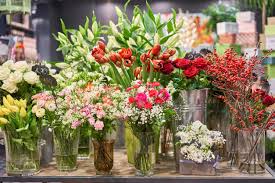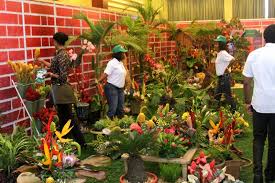![]()
If you’ve landed on this article page, you’re probably searching for a
good business idea—an idea that’s light on the pocket but heavy on
returns, promising both a fulfilling journey and potential profit.
|
How
to start lucrative Cut Flower export from Nigeria
The term cut flower refers to flowers or flower buds (often with
some stem and leaf) that have been cut from the plant bearing
it. It is usually removed from the plant for indoor decorative
use. Typical uses are in vase displays, wreaths and garlands.
Flowers are presented to beloved ones as expression of love and
feelings, it also use during weddings, burials and important
occasions, they are also used as decorations in homes and
offices.The local names for Cut flowers are Fulawa in Hausa,
Okoko in Igbo and
Ododo in Yoruba.
Longevity of cut flowers: Live cut flowers have a limited life.
The majority of cut flowers can be expected to last several days
with proper care. This generally requires standing them in water
in shade. They can be treated in various ways to increase their
life. This is achieved through proper harvesting and the use of
flower preservative solutions. The solution normally contains
carbohydrate, usually in the form of sucrose in addition to
bactericide, fungicide and a wetting agent. The carbohydrate
sustains flowers placed in such solutions. However, it also
tends to speed up their development. This can be an advantage
when flowers especially roses are cut in a tight stage as it
will allow them to open with the use of the solution. The flower
solution also assist in the keeping the foliage of cut flowers
in good conditions. They are used between harvesting and packing
at the florist shop, in the customer’s verse or in stem tubes
during export.
Creating a cutting garden:
Create a cutting garden much the same way you initially
establish a flower garden. Choose a site that receives generous
sun and prepare the soil so that it drains well. Add humus in
the form of compost, peat moss, or chopped leaves to improve
clay or sandy soil. Create one or more beds of whatever size and
shape accommodate the available space. They can be tucked into
sunny spots along the back boundary, in a neglected corner, or
behind the garage. By their very nature, they are transient, so
they are easily changed or reconfigured next season if
necessary.
Grading: The very vital point in grading is that all flowers are
in a bunch must be similar. There are many ways in which they
may differ but the most frustrating for buyers is to find a
short or bent stemmed flower tucked into the centre of a bunch
Quality Properties to be considered are: Size and shape of
texture of flower and its attachment to the stem,(1) Size number
and texture of
petals and their colour intensity, (2)Condition of Calyx (3)
Strength, straightness and length of stem (4) Freedom from
blemish and damages from pests and diseases (5) Stems must be
according to species and variety, rigid and strong enough to
support the flowers
Sizing: For cut flowers, sizing comply with the following scale
from 0 to 5cm, 5 to 10cm, 10 to 15cm and 120cm or more
Flower maturity: Some flowers are cut while still in the bud or
when parity open in order to make storage, packaging and
transport easier and to prolong verse life and market
availability.
Useful tips: Cut the flowers only at a stage after which the
buds can fully open. Flowers for domestic market should be at a
more open bud stage than flowers that are destined for export.
Different market requires flowers at different stages of
maturity. Exporters are advised to crosscheck with the importers
for details.
Global Production of cut flowers: Over the past few decades the
demand for cut flowers has grown considerably moving beyond the
use for special occasion to becoming a more regular decorative
feature of middle and upper income households in the importing
countries. The total hectares of land allocated cut flowers
production worldwide has grown at a fast pace over the past
decades and is estimated at some 200,00 hectares. Annual
consumption of commercially sold flowers is worth approximately
$27billion with the most important varieties being Roses,
carnation and Chrysanthemums. It is worthy to note that the
larger part of the demand is met by production within the major
consuming countries
Global market trend: World imports of cut flowers and foliage
expanded at about 0.7% per annum from 1995 to 1999 and reaching
US43 billion in1999. Developing Countries share in the world
export has risen rapidly since the beginning of the last decade.
The importing Countries: UK, Germany, USA, Netherlands, France,
Japan, Italy, Switzerland, Belgium etc
Emerging market: United Arab Emirates, Saudi Arabia, South
Africa.
Profitability: The return on investment on cut flower is very
high, the price at the international market ranges from 0.5$
to 1$ per piece (Fob) and the orders can be from 500 to
5,000 pieces just imagine how much you will make in one
transaction.
Get our Practical Guide on Cut Flower export from Nigeria. This
comprehensive guide aims to equip aspiring exporters with the
necessary knowledge and insights to successfully export Cut
Flower from Nigeria. It covers essential aspects of the export
process, from market research and legal requirements to
logistics, branding, and sustainable practices. By following
these guidelines, exporters can navigate the intricacies of the
export industry and seize opportunities in international
markets.
|







